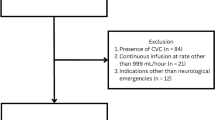Summary
Whole body hyperthermia was performed on 13 anaesthetized and intubated dogs. Cerebral temperature and epidural pressure were measured and related to rectal and oesophageal temperatures. The brain temperature was significantly higher than that of the rectum at normotemperature. The temperature gradients lessened during heating. At maximum rectal temperature (plateau) small differences between the left and right hand sides of the brain were seen, the temperatures being 0.4°C and 0.3°C higher than the rectal temperature, respectively. During the 2-h plateau period the difference between brain and oesophageal temperature became progressively smaller. The mean epidural pressure decreased slightly during the course of the treatment, but remained within the normal range of 1.2±0.4 KPa (8.7±2.5 mm Hg). From this investigation may be concluded that (1) the cerebral temperature is reflected better by the oesophageal than by the rectal temperature and (2) the epidural pressure does not increase during whole body hyperthermia for 2 h at a rectal temperature of up to 42.5°C.
Similar content being viewed by others
References
Baker MA, Chapman LW, Nathanson M (1974) Control of brain temperature in dogs: effects of tracheostomy. Respir Physiol 22:325–333
Barlogie B, Corry PM, Yip E, Lippman L, Johnston DA, Khalil K, Tenczynski TF, Reilly E, Lawson R, Dosik G, Rigor B, Hankenson R, Freireich EJ (1979) Total body hyperthermia with and without chemotherapy for advanced human neoplasms. Cancer Res 39:1485–1493
Benzinger TH, Taylor GW (1963) Cranial measurements of internal temperature in man. In: Hardy JD (ed) Temperature: Its measurement and control in science and industry, vol 3. Reinhold, New York, pp 111–120
Boop WC, Knight R (1978) Enflurane anesthesia and changes of intracranial pressure. J Neurosurg 48:228–231
Bynum G, Patton J, Bowers W, Leav I, Wolfe D, Hamlet M, Marsili M (1977) An anesthetized dog heatstroke model. J Appl Physiol 43:292–296
Cabanac M, Caputa M (1979) Natural selective cooling of the human brain: evidence of its occurrence and magnitude. J Physiol 286:255–264
Dickson JA, Mackenzie A, Mcleod K (1979) Temperature gradients in pigs during whole-body hyperthermia at 42°C. J Appl Physiol 47:712–717
Field SB, Bleehen NM (1979) Hyperthermia in the treatment of cancer. Cancer Treat Rev 6:63–94
Ingram DL, Mount LE (1975) Man and animals in hot environments. In: Schaefer KE (ed) Topics in environmental physiology and medicine. Springer, Berlin Heidelberg New York, pp 1–81
Lees DE, Kim YD, Bull JM, Whang-Peng J, Schuette W, Smith R, Macnamara TE (1980) Anesthetic management of whole-body hyperthermia for the treatment of cancer. Anesthesiology 52:418–428
Minard D, Copman L (1963) Elevation of body temperature in health. In: Hardy JD (ed) Temperature: Its measurement and control in science and industry, vol 3. Reinhold, New York, pp 527–543
Moricca G, Cavaliere R, Caputo A, Bigotti A, Colistro F (1977) Hyperthermic treatment of tumours: Experimental and clinical applications. In: Rossi-Fanelli A, Cavaliere R, Mondovi B, Moricca G (eds) Recent results in cancer research, vol 59. Springer, Berlin Heidelberg New York, pp 112–152
Parks LC, Minaberry D, Smith DP, Neely WA (1979) Treatment of far-advanced bronchogenic carcinoma by extra corporeally induced systemic hyperthermia. J Thorac Cardiovasc Surg 78:883–892
Sklar FH, Elashvili I (1977) The pressure-volume function of brain elasticity. J Neurosurg 47:670–679
van Rhoon GC, van der Zee J (1981) Temperature distribution during whole body hyperthermia (Abstr). Strahlentherapie 157:621–622
Author information
Authors and Affiliations
Additional information
Supported by a grant from the “Koningin Wilhelmina Fonds“: KWF 77-4
Rights and permissions
About this article
Cite this article
van Rhoon, G.C., van der Zee, J. Cerebral temperature and epidural pressure during whole body hyperthermia in dogs. Res. Exp. Med. 183, 47–54 (1983). https://doi.org/10.1007/BF01851762
Received:
Accepted:
Issue Date:
DOI: https://doi.org/10.1007/BF01851762




